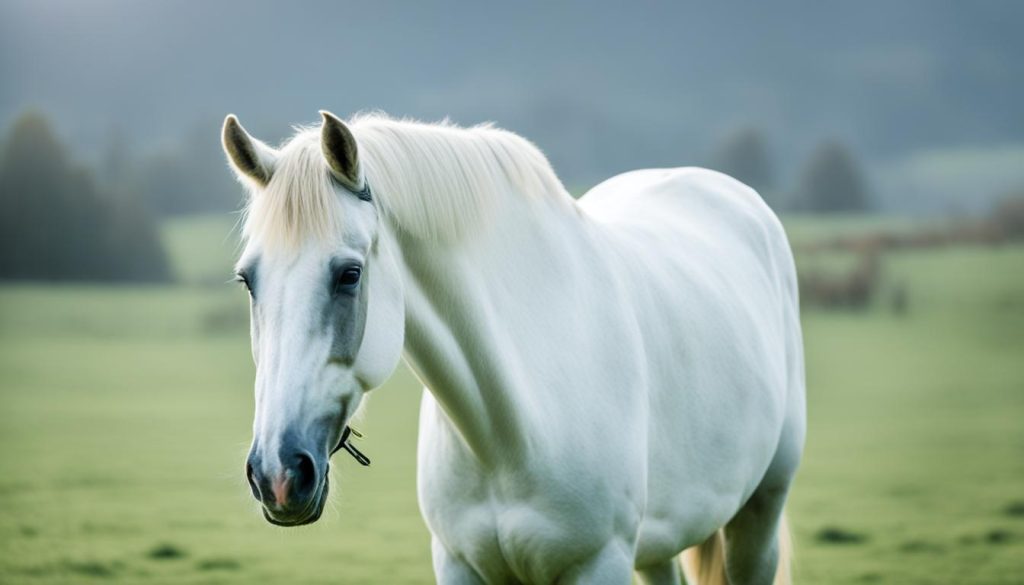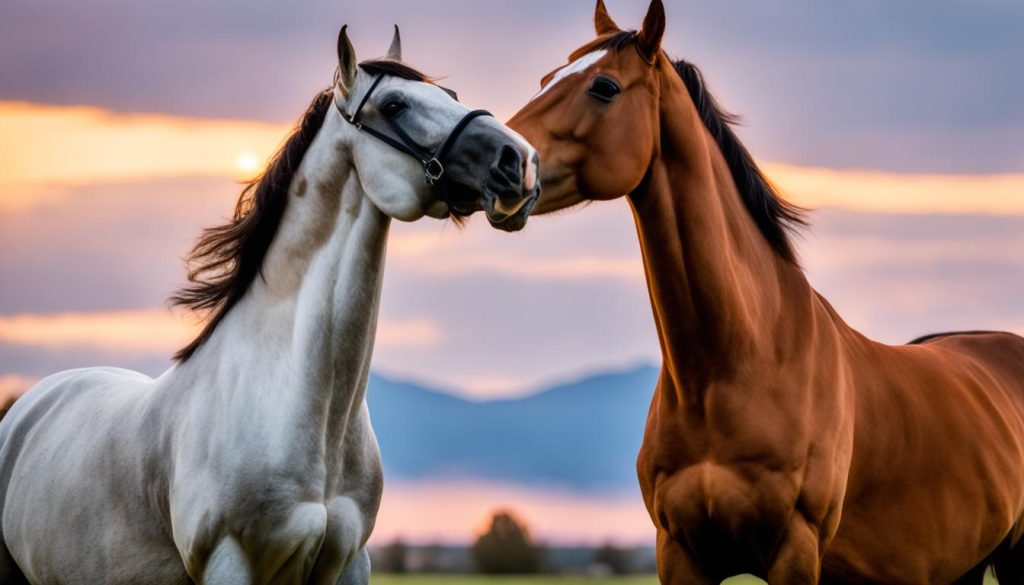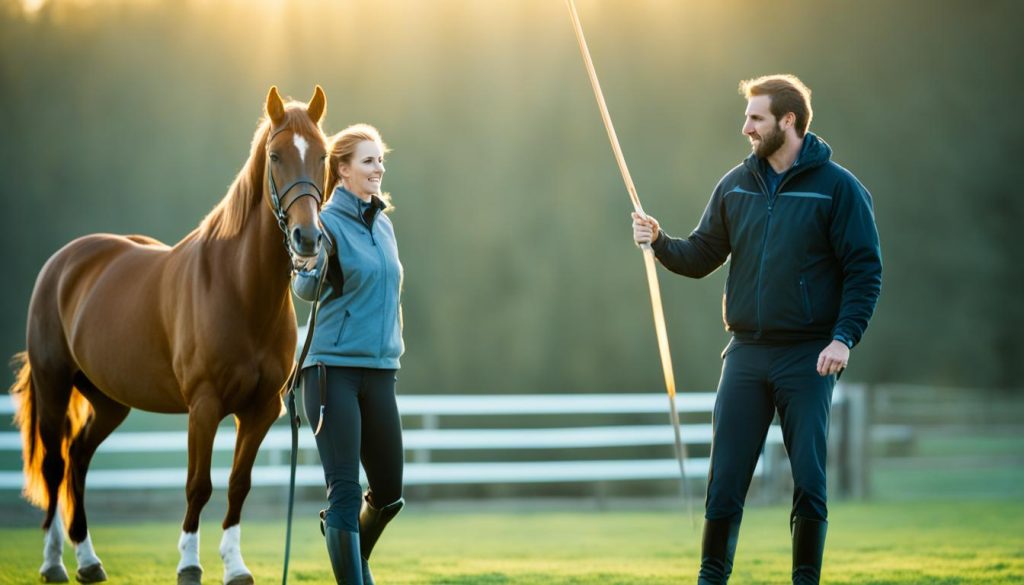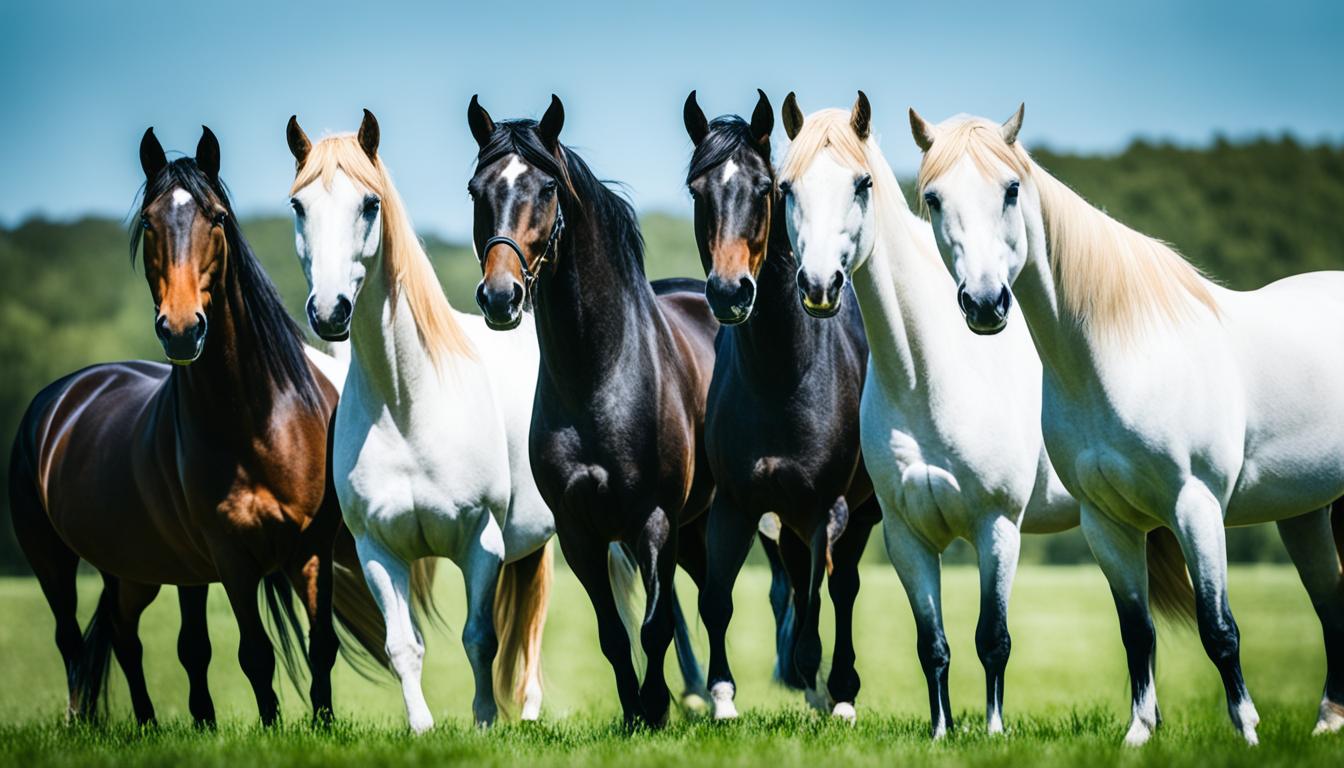Did you know that horses are capable of forming strong pair-bond relationships? These majestic creatures have a complex and fascinating behavior that can be both intriguing and challenging for horse owners and trainers. Understanding horse behavior is crucial to ensure the well-being and training success of these magnificent animals.
Key Takeaways:
- Understanding horse behavior is essential for effective horse training and management.
- Horses rely on their senses to interact with their environment and have unique behavioral characteristics.
- Communication plays a vital role in horse behavior, involving body language, vocalizations, and gestures.
- Positive reinforcement and clear cues are key to successful horse training techniques.
- Gaining insights into horse psychology can lead to better behavior, improved performance, and a stronger bond between horse and human.
The Basics of Horse Behavior
Horses have fascinating and complex behavior patterns that have been shaped by their evolutionary history and interactions with humans. Understanding the basics of horse behavior is essential for anyone involved in horse training and management. In this section, we will explore key aspects of horse behavior, including their senses, communication, domestication, and more.
Horse Senses
Horses rely on their well-developed senses to navigate and interact with their surroundings. Their acute hearing allows them to detect sounds from long distances, while their large, expressive eyes provide excellent vision, especially in low-light conditions. Horses also have a keen sense of smell, which plays a role in their communication and recognition of other horses.
Horse Communication
Horses are highly social animals and rely on a variety of communication methods to interact with each other. They use body language, such as ear position, tail swishing, and facial expressions, to convey their emotions and intentions. Vocalizations, such as neighs and whinnies, are also part of their communication repertoire.
“Horses use a combination of body language, vocalizations, and gestures to communicate with each other and with humans.”
Understanding horse communication cues can help you develop a deeper connection with your horse and improve your training techniques.
Domestication & Behavior
The domestication of horses has had a significant impact on their behavior. Through centuries of selective breeding and interaction with humans, horses have become more docile and better suited for various tasks and disciplines. However, their innate behaviors and instincts, such as their flight response and herd dynamics, still influence their behavior today.
Mating Behavior
Horse mating behavior is a natural and essential part of their reproductive cycle. Horses exhibit specific courtship rituals, including vocalizations, body posturing, and physical displays, to attract a mate. Understanding these behaviors can help horse breeders manage successful breeding programs.
Feeding Behavior
As herbivores, horses have specialized feeding behaviors. They graze on forage, such as grass and hay, for the majority of their diet. Horses have adapted to grazing by developing a unique digestive system that allows them to extract nutrients efficiently from plant material. Understanding their feeding behavior is crucial for proper nutrition and overall health.
Abnormal Behavior
Occasionally, horses may exhibit abnormal behaviors that warrant attention and intervention. These behaviors can be signs of distress, pain, or underlying health issues. Recognizing abnormal behaviors, such as cribbing or weaving, is important for identifying and addressing potential problems promptly.
By delving into the basics of horse behavior, you can enhance your understanding and connection with these majestic animals. The next section will explore horse communication and body language in more detail.

Horse Communication and Body Language
Communication is a crucial aspect of horse behavior. Horses use a combination of body language, vocalizations, and gestures to express themselves and interact with other horses and humans. Understanding their signals can facilitate the development of stronger relationships between horse owners, trainers, and their equine companions.
One way horses communicate is through their ear position. The position of a horse’s ears can convey their mood and level of attentiveness. For example, forward-pointing ears typically indicate that a horse is engaged and alert, while pinned-back ears may suggest aggression or discomfort.
Another important signal is the tail position. A raised tail often signifies excitement or anticipation, while a tucked tail can indicate fear or submission. It’s crucial to observe these cues and respond appropriately to ensure effective communication.
Facial expressions are also significant indicators of a horse’s emotions. Pay attention to their facial expressions such as the position of their eyes, nostrils, and mouth. Widened eyes, flared nostrils, and bared teeth can signify stress or agitation, while relaxed facial features typically indicate contentment.
Horses also use body movement to communicate. For instance, a horse that repeatedly paws the ground may be indicating impatience or frustration, while a horse that pins their body against a wall or fence may be signaling discomfort or a desire for personal space.
Additionally, horses express themselves through vocalizations. Common vocalizations include neighs, snorts, and nickers, each of which may have unique meanings. For instance, a nicker typically indicates a friendly or welcoming attitude, while a snort might indicate arousal or apprehension.
By understanding these various modes of communication, horse handlers can effectively interpret their horses’ needs, emotions, and intentions. Building this language of communication and responding appropriately can strengthen the bond between horses and their human counterparts.
Developing a Deeper Understanding
Observation is key to understanding and interpreting horse communication. Spend time with your horse, observe their body language, and note the contexts in which they exhibit specific signals. As you deepen your knowledge and experience, you’ll become more attuned to their unique gestures and vocalizations.
“When working with horses, it’s important to remember that they are highly attuned to our energy and body language. By being present and aware, we can communicate effectively and build trust”
Equipped with this understanding, you can fine-tune your training techniques, respond appropriately to your horse’s needs, and foster a more harmonious and productive relationship.
| Horse Communication Signals | Meaning |
|---|---|
| Forward-pointing ears | Engagement and attentiveness |
| Pinned-back ears | Aggression or discomfort |
| Raised tail | Excitement or anticipation |
| Tucked tail | Fear or submission |
| Widened eyes, flared nostrils, bared teeth | Stress or agitation |
| Relaxed facial features | Contentment |
| Pawing the ground | Impatience or frustration |
| Pinning body against a wall or fence | Discomfort or desire for personal space |
| Neighs, snorts, nickers | Varying meanings based on context |
Remember, effective communication with your horse begins with observation, patience, and a willingness to learn their unique language. By understanding and responding to their signals, you can build a stronger connection and partnership.

Horse Training Techniques
Effective horse training techniques are crucial for shaping a well-behaved and responsive equine companion. By understanding a horse’s behavior and psychology, you can employ methods that promote positive learning and development. One widely recognized approach is reward-based training, commonly known as positive reinforcement. This technique involves using treats or praise to reward desired behaviors, allowing the horse to associate obedience with positive outcomes.
Another valuable method is desensitization, which involves gradually introducing the horse to potentially frightening or challenging stimuli in a controlled environment. By exposing the horse to these situations in a calm and supportive manner, you can help them overcome fears and develop trust.
“Desensitization is an essential component of horse training. It helps horses become more confident and less reactive to stimuli that may otherwise cause stress or anxiety.”
– Jane Peterson, professional horse trainer
Counter-conditioning is another effective technique that involves associating a negative or unwanted behavior with a positive response. For example, if a horse displays anxiety or aggression during grooming, counter-conditioning would involve rewarding the horse for calm and cooperative behavior during grooming sessions. Over time, the horse learns to associate grooming with positive experiences, reducing their negative response.
Systematic desensitization is a method that gradually exposes the horse to a specific trigger, such as loading onto a trailer, in a step-by-step process. By breaking down the task into small, manageable steps and rewarding the horse’s progress along the way, you can help them overcome fear or resistance towards the specific task.
Consistency, trust, and clear communication are key elements in successful horse training. Establishing a routine and using clear cues enable the horse to understand your expectations. It’s essential to remain patient and allow the horse time to process and respond to your commands. Remember, training sessions should be engaging and rewarding for both you and your horse.
Using these horse training techniques requires knowledge, skill, and a deep understanding of equine behavior. Consider working with a professional horse trainer or seeking guidance from experienced equestrians to ensure you are applying the techniques correctly and safely.
Benefits of Effective Horse Training Techniques:
- Establishes a harmonious relationship between the horse and handler.
- Promotes trust and respect, leading to improved obedience.
- Reduces anxiety and fear-based behaviors.
- Increases the horse’s confidence and ability to handle new or challenging situations.
- Enhances safety for both the horse and handler.

Conclusion
Understanding horse behavior is crucial for horse owners and trainers to effectively care for and train their horses. By gaining insights into horse psychology, communication, and training techniques, you can develop a strong partnership with your horse.
Building a foundation of understanding allows you to utilize positive training methods, resulting in better behavior, improved performance, and a stronger bond between you and your equine companion.
With knowledge and patience, anyone can become a competent horse handler and foster a harmonious relationship with their horse. Remember to always prioritize your horse’s well-being and use the principles of understanding horse behavior, horse psychology, and horse training techniques to guide your training journey.
